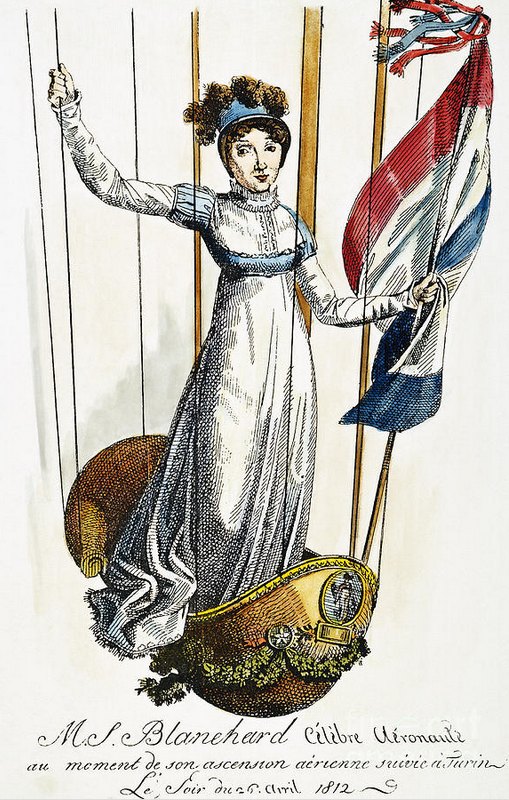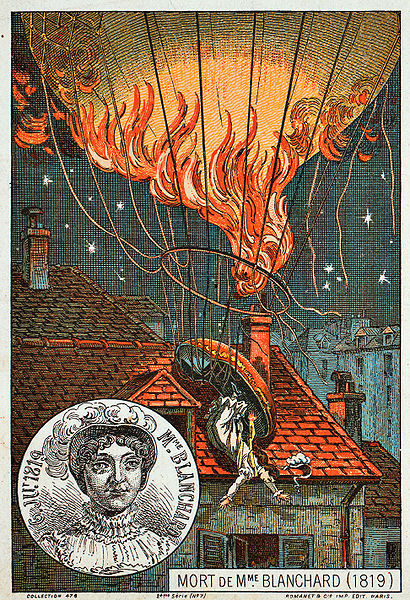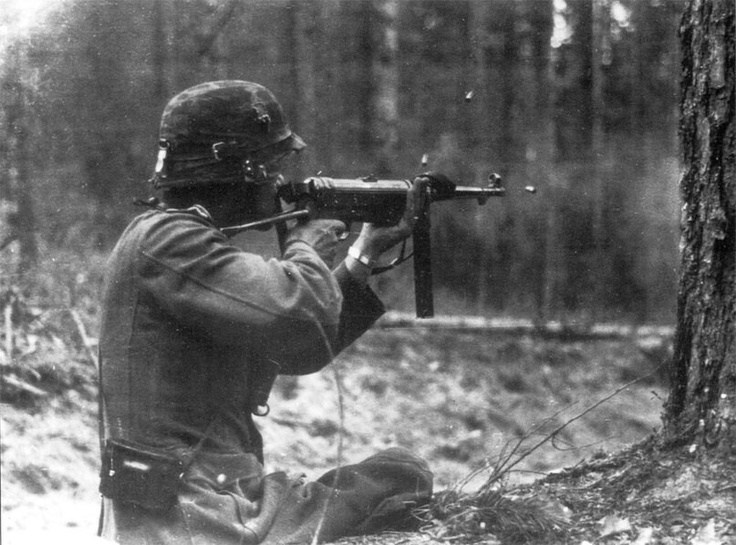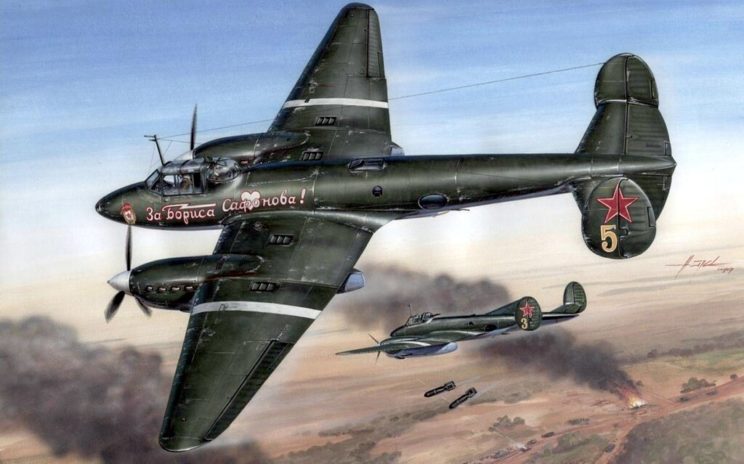Sophie Blanchard broke many of the first gender barriers in aviation, only for them to go up again after she was gone
Last month, I had the opportunity to write a couple of guest posts for Women’s History Month. I’d originally wanted to highlight pioneering balloonist Sophie Blanchard as an overlooked subject for historical fiction. But her life story begged for a longer piece and she does in fact have a couple of books based on her life. So I saved my post for here instead.
This is also part of a new feature I’d like to try. The Real is where I’ll highlight a real-life historical personality and make book recommendations (particularly fiction based on their lives.)
Sophie Blanchard was one of history’s earliest aviators. In the early 19th century, she became the first woman to pilot her own balloon and also became the first female military aviator, appointed by Napoleon himself!
The Dawn of Human Flight (The Survivable Kind)
The first humans to take to the air by artificial means were the Montgolfier brothers in their hot air balloon. From that moment, France’s relationship with early aviation was set. It’s not surprising that France also lays a claim to hosting the the world’s first powered flight. Brazilian Alberto Santos-Dumont’s 1906 flight in Paris remains the most serious counter-claim to the Wright Brothers’ Kittyhawk flight.
One area of aviation firsts that is not in dispute is the contribution of French women to the first century of flying.
Marie Élisabeth Thible was the first woman to take to the air. Just one year after the Montgolfiers’ flight, ballooning demonstrations were popular entertainment. One such demonstration took place in 1784 to celebrate the King of Sweden’s visit to Lyon. Originally, another honoured guest, the Count de Laurencin, was supposed to be the passenger in a 2-man gondola. The Count backed out at the last minute. The balloonist recruited Thible, an opera singer, to replace him and make history. She also performed two songs in mid-air!
The first woman to fly a plane was also French. Raymonde de Laroche. She flew in 1909, just a scant few years after the Wrights and Santos-Dumont. Not satisfied with being a novelty, she also became the first to get her pilot’s license, flying airshows and setting early distance records. Laroche even tried to join the Air Force during the First World War.
In the century between Thible and Laroche’s first flights, perhaps the most fascinating individual exploits belonged to Sophie Blanchard. An early aerial daredevil, she was the first woman to fly solo, the first to enter military aviation and, sadly, the first to die in a flying accident.
Humble Beginnings
 Sophie Blanchard was an unlikely candidate to be a flying pioneer. She was of nervous disposition, so much so that she was frightened of riding in horse carriages. Her hidden talents only became apparent after marrying the much older Jean-Pierre Blanchard sometime in the late 1790s or early 1800s. Jean-Pierre had a reputation as an intrepid balloonist, bordering on reckless. He had a pair of firsts to his name as well: he was the first to fly a hydrogen balloon and, with an American partner, the first to cross the English Channel by air.
Sophie Blanchard was an unlikely candidate to be a flying pioneer. She was of nervous disposition, so much so that she was frightened of riding in horse carriages. Her hidden talents only became apparent after marrying the much older Jean-Pierre Blanchard sometime in the late 1790s or early 1800s. Jean-Pierre had a reputation as an intrepid balloonist, bordering on reckless. He had a pair of firsts to his name as well: he was the first to fly a hydrogen balloon and, with an American partner, the first to cross the English Channel by air.
Jean-Pierre made a living with ballooning demonstrations. He took Sophie up, initially to generate publicity. She took to it immediately. Soon, she became the first woman to pilot her own aircraft when she flew solo. She became a sensation at a time when ballooning was all the rage and the wealthy paid large sums of money to ride along. Her reputation was such that Napoleon named her France’s “official balloonist” in 1804, giving demostrations at public festivals.
Untethered
Jena-Pierre suffered a heart attack in mid-flight in 1809, falling and dying of his injuries. He left Sophie with many debts. She moved past Jean-Pierre’s death and became a famous balloonist in her own right. She would often add pyrotechnics to her airshows.
But she was not just for show. Napoleon proceeded to make her “chief air minister” at a time when the possibilities of military aviation were first being explored. Reportedly, she was asked to study invading England from the air. Her verdict: not likely.
Even with Napleon’s downfall, she remained in good graces at the court of the restored French monarchy, still dazzling audiences with her demonstrations.
She was also fearless in pushing the limits. She frequently flew untethered, risking high winds that on one occasion smashed her balloon against houses and trees, throwing her from the gondola. Flying as high as 12,000 feet, she nearly lost consciousness crossing the Alps. She also survived ditching in a swamp. Fireworks set off beneath her gondola were a regular feature of her shows, despite the balloon being filled with hydrogen.
The Last Show

In 1819, Blanchard readied to perform what she called her “last show” at the Tivoli Gardens in Paris. The audience were eagerly anticipating a new feature, called “Bengal Fire.” Dressed all in white with an ostrich feather hat, Blanchard dropped fireworks from parachutes while holding a torch. Suddenly, her balloon caught fire. The audience, mistaking the rampant flames as part of the show, applauded wildly.
Despite the danger, she managed to bring her balloon into a slow descent. It was only on colliding with a house that she fell out of the gondola to her death. She was 41.
Sophie Blanchard had been full of contrasts. She was timid on the ground, yet fearless in the air. Introduced to aviation as a showpiece for her husband, she took the controls and never looked back. Her career showed what was possible for a woman to accomplish in her time. Even after her death, the contrasts continued. Her demise was used as an excuse to exclude women from flying. Once among the most famous people in Europe, she’s now an obscure figure who deserves a much more prominent place in history.
Further Reading
Part of the idea of this post was to highlight books about its real-life subject. Despite being relatively unknown to history, Sophie Blanchard has both a historical novel and a children’s book dedicated to her life.
The Little Balloonist, by Linda Donn

A fictionalized version of Sophie Blanchard gets the historical romance treatment in Linda Donn’s 2006 novel. My favourite megalomaniacal dictator, Napoleon, also plays a major part.
Lighter than Air, by Matthew Clark Smith

Sophie Blanchard’s story shows not only that women can achieve just as much as men. She also showed that fears can be overcome in spectacular ways. It’s not surprising her life makes for a great children’s book.


That’s so cool, I hadn’t heard of Sophie Blanchard before 🙂 such a shame the way she died though 🙁 but what better way to go than doing the thing you love. Kind of ominous that she called it her last show as well :/
Yes, she was a showwoman to the end. Thanks for reading!